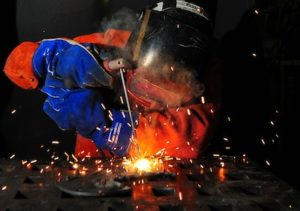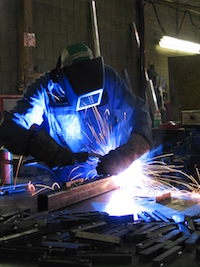 The term “complex” aptly describes the inner workings of most welding processes, as researching the exact sciences behind today’s welding machines will leave the average person’s head spinning for hours. However, welding didn’t always rely upon complicated engineering designs. Instead, welding techniques improved over thousands and thousands of years from their humble beginnings in ancient human societies.
The term “complex” aptly describes the inner workings of most welding processes, as researching the exact sciences behind today’s welding machines will leave the average person’s head spinning for hours. However, welding didn’t always rely upon complicated engineering designs. Instead, welding techniques improved over thousands and thousands of years from their humble beginnings in ancient human societies.
Admittedly the earliest welding techniques bear almost no resemblance to the techniques we see utilized by today’s welders. Instead, early civilizations heated pieces of metal to redness and used simple tools to manually join them, a tedious process that took hours for laborers to complete simple welds. However, these inefficient techniques still generated strong results for their users. The Iron Pillar of Delhi, a 24 foot high structure manufactured from forge welding in the 4th century, still exhibits strong resistance to corrosion after thousands of years.
Somehow these now-outdated methods for welding metals experienced scarce improvements until the early 19th century, despite the growing numbers of tools and structures that were fabricated from welding. Smiths, as European countries called welders, rose to great popularity in their cities and towns for offering advanced tools. As metallurgy progressed the smiths were able to create better and stronger weapons and tools from iron and steel to defeat enemies using weaker metals.
In the early 1800s two cousins discovered separate innovations that set the stage for the modern welding revolution. Sir Humphry Davy produced the first short-pulse electric arc in the year 1800 by transmitting an electric current through two touching carbon rods and pulling the rods apart. 36 years later, Humphry’s younger cousin Edmund Davy accidentally discovered acetylene by creating potassium chloride, which reacted with water and released acetylene. These separate discoveries provided the necessary technology for the incoming commencement of modern welding.
In 1881 inventors finally applied the electric arc to create new welding techniques. That year, French inventor Auguste de Méritens received a patent for his carbon arc welding torch and Russian inventor Nikolai Benardos demonstrated his own carbon arc welding technique at the International Exposition of Electricity in Paris.
In the same period inventors also took advantage of Edmund Davy’s discovery of acetylene. In 1903, Edmond Fouché and Charles Picard worked together to develop oxygen-acetylene welding, more commonly referred to as oxy-fuel welding. Fouché and Picard found that the incredible heat generated from the burning of acetylene when combined with oxygen provided enough heat to weld metals together.
 From the point of its invention until the late 1920s, oxy-fuel welding dominated the welding industry. Arc welding remained in its relative infancy, and no other welding techniques offered welders the ability to create strong welds in almost all metals. Oxy-fuel welding kicked off the era of modern welding and obliterated the standards for efficiency that welders were accustomed to at that time.
From the point of its invention until the late 1920s, oxy-fuel welding dominated the welding industry. Arc welding remained in its relative infancy, and no other welding techniques offered welders the ability to create strong welds in almost all metals. Oxy-fuel welding kicked off the era of modern welding and obliterated the standards for efficiency that welders were accustomed to at that time.
As you may know, the reign of oxy-fuel welding for industrial purposes was very short-lived. Throughout the early 20th century, arc welding continued to develop and improve. In 1900, Arthur Percy Strohmenger unveiled the first coated metal electrodes to the world. Metal electrodes were already in use in arc welding for around a decade at that point, but these arcs were too unstable to be practically used in the industry over oxy-fuel welding. Strohmenger’s coated electrodes solved this key issue, but proved to be too expensive for popular consumption upon their initial release. It wasn’t until an extrusion process, which was developed in 1927, was able to reduce the cost of coating electrodes. This change eventually pushed arc welding over oxy-fuel as the most popular welding technique for industrial purposes. Oxy-fuel welding failed to compete with greater speed and efficiency of arc welding techniques.
The majority of arc welding jobs use one of three techniques: metal inert gas (MIG) welding, tungsten inert gas (TIG) welding, or shielded metal arc welding, more popularly known as “stick” welding. Stick welding predates the other two methods, as this process dates all the way back to the aforementioned earliest inventions of coated metal electrodes. These electrodes are used to strike a metal workpiece and initiate and electric arc, which generates enough heat for welding. This technique remains as a popular choice among welders because of the versatility, simplicity, and low cost of the technique.
Despite the initial dominance of stick welding, MIG welding is the current favorite method for welders in industrial environments. Fabricators prefer MIG welding because the welds are clean and do not sacrifice any efficiency. H.E. Kennedy of the Battelle Memorial Institute developed the technique in the year 1948 by using a smaller diameter electrode wire with a constant voltage power source. In MIG welding, a consumable and continuous metal wire electrode creates the electric arc for the weld and joins the two base materials together. During the welding process, a shielding gas is released to protect the weld from atmospheric contamination that could negatively impact the quality of the weld.
TIG welding’s development put the nail in the coffin for oxy-fuel welding, as TIG welding gave fabricators the option to cleanly work with highly reactive metals like titanium, which were dangerous in combination with acetylene. Russell Meredith, a welder at Northrop Aircraft Corporation, invented the technique in the 1940’s because he found other methods inadequate for aluminum and magnesium alloys. To complete a tungsten inert gas weld, the welder feeds a filler metal rod into the weld puddle with one hand and controls the arc with the other. The filler rod melts and fills the cavity between the two pieces of metal to form a strong weld.
Modern welding didn’t exist in the 19th century. Throughout the last 220 years, the welding industry experienced monumental change that propelled it into the position it is in today. Welding is now crucial to the fabrication industry, and it is impossible to imagine today’s world without the technological advancements made to modern welding. Aquasol Corporation continues to innovate and build upon the legacy left by the great engineers and welders by introducing new and more efficient methods of welding that will continue to shape the world around us.
© 2025 Aquasol Corporation. All Right Reserved.
